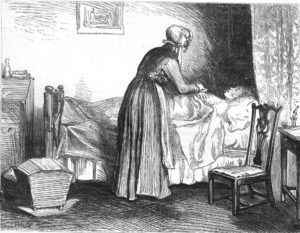Our Doula Foremothers
by Lisa Feldstein
It is rare that care of the dead and the care of the dying are discussed among the myriad caregiver responsibilities women have always held in their homes and communities. Yet this work was done almost exclusively by women until the Civil War. Curious about our calling’s foremothers, I did a little digging. What I found primarily describes practices in white, Christian society from Colonial times to the early 20th century.
For most of history, almost everyone was born and died at home. Since the home was the woman’s domain, care for the dying fell to women. High maternal mortality rates during birth meant that the women attending during labor — family members, neighbors, and, when available, midwives — would often wash and dress a newborn baby and the baby’s deceased mother simultaneously.
While care for the dying fell to the family’s women, there were also women whose professions were caring for the dead and dying. Some midwives offered these services, but there were also women who specialized in care for the dead and dying. The work of these professional women, frequently widows in need of an income, was divided into two distinct roles: “Layers-out” (also called “Shrouding women”), and “Watchers.”
Layers-out washed, groomed, fixed, dressed, and shrouded corpses, tasks that today are generally completed by funeral directors. By the late 18th century, layers-out were highly trained, skilled, experienced practitioners, many of whom learned from their mothers or grandmothers. The knowledge they passed down included recognition of the intricate differences various diseases and climates had on decomposition, disguising disfigurement, removal of internal organs, sewing up of corpses, and preserving bodies on ice to allow time for widely dispersed family members to arrive. These women were often skilled seamstresses as well, which was advantageous when dressing the deceased.
The professionals who cared for the dying were known as “watchers.” The work these women did will sound familiar to end of life doulas: tending to the physical, spiritual, and social needs of the dying. Watchers adjusted bedclothes, offered food, water, and medicine, and managed bodily evacuations. Spiritual tasks included praying and arranging visits by clergy and other religious persons. Watchers welcomed visitors and loved ones to the side of the dying.

The concept of the “Good Death” gained currency in the 19th century. Many of the attributes of a good death are unchanged. The contexts differ, however, and so, accordingly, do the respective roles of the watcher and doula.
We as doulas work with our clients to clarify the individual’s idea of a good death. In contrast, the 19th century Good Death was rigidly defined by religion and culture. Watchers carefully observed the dying person’s attitude toward death; a Good Death meant the person met the end with courage, confident resignation, and faith. When the dying struggled against death, experienced tremendous pain and trauma, and repudiated the divine, observers noted that they had experienced a Bad Death.
Watchers hoped their testimony of a loved one’s Good Death demonstrated the Christian devotion of the decedent, thus consoling the bereaved. Kind watchers might not share Bad Deaths with the bereaved – or they might use these deaths as lessons, warning the bereaved to fortify their own faith and change their behavior.
The fear of being buried alive was so great at this time that it defined the most significant responsibility of the watcher: verifying that the person was, in fact, dead. Watchers looked closely to see if the individual was breathing and shook the body to see if life remained before acknowledging that the person had transitioned, signaling that the family should commence mourning and calling in those who would prepare the body.
The Civil War brought a sea change in technology and how death was understood by society. Embalming allowed soldiers’ corpses to be returned to their families for burial, while the necessity of handling large numbers of dead soldiers created an industry from what had been local practices. As undertakers became commonplace, the traditional women’s roles declined. By the 20th century, the watchers and layers-out had vanished. Nonetheless, doulas owe a great deal to these women, our foremothers in the effort to provide the dying with comfort, dignity, and peace.
